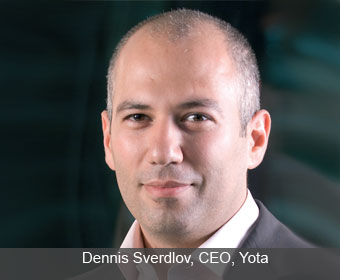Dennis Sverdlov, Yota CEO, talks to Ken Wieland about his ambitious plans to use WiMAX to dominate the fixed and mobile broadband markets in Russia.


sverdlov2
Dennis Sverdlov, Yota CEO, talks to Ken Wieland about his ambitious plans to use WiMAX to dominate the fixed and mobile broadband markets in Russia.Russia-based Yota is positioning itself to be one of the biggest mobile WiMAX operators in the world. Its target is to cover nearly all of Moscow and St Petersburg with an 802.16e network this year, and extend its reach to 40 of Russia’s largest regional cities by the end of 2011.
Dennis Sverdlov, Yota’s CEO, is convinced that Russia’s cable and mobile operators will find it difficult to match the company’s 802.16e-based service package in terms of price, content and network performance. He dismisses the notion that LTE could make an appearance in Russia anytime soon, a development which would pose a serious competitive threat to a nascent Yota.
“Due to the financial crisis, Russia’s 3G operators haven’t got enough cash to invest in new technologies,” he says. “There are also backhaul issues that cellular operators need to address if they are to offer faster speeds. LTE won’t be ready in Russia for another five years, at least.”
Headquartered in St Petersburg, Yota-the brand name of Scartel LLC, which, in turn, is owned by WiMAX Holding Ltd-launched a pilot WiMAX service in both Moscow and St Petersburg in September 2008. Using 400 base stations from Samsung, Yota now boasts a population coverage of around 20 million across Russia’s two biggest cities, which is about 70 per cent of their combined total population. Yota has already put in place its own backhaul network in Moscow and St Petersburg. Comprising 1,207km of fibre-optic cable, it is capable of supporting peak data rates of up to 180Gbps. Yota’s aim is to expand mobile WiMAX coverage in Moscow and St Petersburg this year to achieve nearly full population coverage in these cities using a total of 1,600 Samsung base stations.
Progress has also been made at broadening the type of WiMAX devices that can access the Yota network, he says. Two months after the pilot launch, Yota unveiled the world’s first dualmode mobile WiMAX/GSM touchscreen handset-the MAX 4G-manufactured by Taiwanese vendor HTC. The device is capable of seamlessly roaming between Russia’s GSM networks and Yota’s 802.16e service, but there is a drawback: Users will receive two bills; one from their GSM provider and one from Yota. Voice calls will be free, however, if they remain on the WiMAX network.
Handset cost might prove a further disincentive. The HTC MAX 4G, carries a hefty price tag of around US$1,200, making it the most expensive mobile handset available in Russia (iPhones retail for around $1,000). But Yota offers cheaper WiMAX devices as well.
Customers can purchase either a USB dongle or an express card, both supplied by Samsung, for around $130 each. There are also WiMAX-embedded laptops from Asus, Lenovo, Acer, MSI and Samsung, as well as a mobile WiMAX/wifi centre from Asus. Targeted at small businesses, the centre can connect to both wifi and mobile WiMAX networks, as well as provide simultaneous wired ethernet connections for four PCs and two phones (or fax machines).
And in March 2009 Samsung and Yota announced the introduction of what they claim is the first ‘4G’ ready netbook in Russia. A modified Samsung NC10, the new device has a built-in mobile WiMAX module plus software to connect to Yota’s 802.16e network. The NC10 retails for around $600. While unit prices might seem high to some readers, the Russian mobile market has no history of device subsidies, which means that Russian consumers expect to pay higher prices for devices than many of their western counterparts.
The trade-off, though, is that there is much greater resistance to higher monthly charges in Russia than in the most developed European markets. As such, Yota offers what appears-from a western European perspective-a very generous bundled package of services for consumers, which will be priced at around $30 per month (with weekly and daily rates also available) when the services eventually go commercial, scheduled at the time of writing for June 1st. In the meantime, Yota’s services are free for those purchasing any of the operator’s devices through its retail outlets and website.
“We haven’t released the exact figures for the number of devices we have sold but I can tell you it’s around 50,000,” says Sverdlov. “Of that number, we have shifted around 35,000 HTC MAX 4G handsets with the majority of the remainder being USB dongles. But because we haven’t started commercial service, we haven’t had much of a marketing or advertising campaign. We’re not making much of a push right now.”
Yota holds chunks of spectrum between 20MHz and 40MHz in size in the 2.5GHz band across Russia. It acquired much of its spectrum assets through the purchase of MMDS (multi-channel multipoint distribution service) operators but in May it remained illegal in Russia to use 2.5GHz for commercial point-to-multipoint and mobile data communications. Yota, as well as other 2.5GHz spectrum holders in Russia with mobile WiMAX ambitions in this frequency band-including big guns Comstar and Synterra-can still offer data communication services, but only if they don’t charge for them. In smaller cities and towns (populations under 100,000,) the Russian regulator does allow 2.5GHz operators to charge for point-to-multipoint data communications, but this doesn’t help Yota, as it is targeting Russia’s larger cities.
The situation is far from ideal from the point of view of, [Yota’s business case] and clearly the regulatory bottleneck has not eased as quickly as Sverdlov had originally anticipated. At the beginning of March, Yota announced it was extending its free trial period, which was originally due to end on April 1st, until 31st May. But Sverdlov is confident that the regulatory hurdles will be overcome so commercial service can begin on June 1st. He points out that Yota already launched video-based services for corporate customers on April 1st, the date it originally intended to do so.
“We need 200,000 [paying customers] to break even from an operational point of view,” says Sverdlov. “We can achieve that number this year.” He says that $300m has already been spent on infrastructure and services, with a further $170m slated for capex this year. “Financially, we are very comfortable,” he adds. “Our plans for 2009 are fully funded.”
One reason for this comfort, perhaps, is that Yota has the backing of Rostechnologii, a non-profit state corporation that supports Russian technology-focused enterprises. For an undisclosed sum, Rostechnologii purchased a 25.1 per cent stake in WiMAX Holding on November 1st 2008. The remaining equity in WiMAX Holding is held by Telconet Capital Limited Partnership, a private investment fund. The state involvement in Yota (via WiMAX Holding), combined with a lack of transparency related to Telconet investors, has led to some speculation that Yota has received favourable treatment from the regulator, particularly as it has been able to install so many base stations for widespread service deployment before any official approval has been given for commercial data services at 2.5GHz.
Yota offers a range of multimedia services on top of its high-speed internet access (up to 10Mbps). These include ‘Yota Music’, comprising an online music catalogue of more than 50,000 titles, including a wide range of music from both international and independent music labels. Users can choose to either play the tracks direct from the online catalogue, or download them to the HTC MAX 4G’s 8GB of onboard flash memory.
There is also ‘Yota Video’, a video-on-demand service broadcasting 23 channels. The 3.8-inch touchscreen of the HTC MAX 4G can display up to nine TV channels simultaneously, which, says Yota, allows for easier navigation between the TV channels. In addition, there is Yota TV (broadcasting 12 free channels) and Yap-Yap (a photo-blogging service).
As these services will be bundled into Yota’s flat-rate packages from June 1st, Sverdlov believes the firm is capable of beating the competition from mobile and cable operators hands down. “We have faster speeds, better performance and lower prices,” he says. “And what is interesting is the usage of the WiMAX device. More than 50 per cent of all devices are being used for our video or TV services, but very little time is spent on external sources, such as internet access. They generally don’t go outside our network. Of course, there is some external use for email, but the traffic is not huge.”
By Sverdlov’s reckoning, this proves that Yota has managed to put together an attractive service portfolio, backed up by a high-speed network capable of delivering those services in fixed, nomadic and mobile environments. Sverdlov reports that Yota’s non-paying customers typically download 10GB of data every month, which is more than twice the average download volume for cable customers.
“Our customers don’t just use the services on the road,” adds Sverdlov. “They repeatedly use them at home and at work.” Although Yota is intent on nationwide rollout and has money to spend, the only infrastructure vendor beneficiary will be Samsung. “I’m not interested in pursuing a multi-vendor strategy as we’re very focused and happy on what we have right now,” says the Yota CEO. “If we did select another vendor, we would have to undertake IOT with other devices and spend time understanding what’s inside the other equipment. We just don’t have time for that. And anyway, we have got quite good [contract] conditions with Samsung.”
Sverdlov is also happy with Samsung user devices on the Yota network. “We have tested many devices in our labs and it’s true Samsung devices are quite expensive compared with other companies. But they can support Linux and Windows, have very high performance chipsets and they work on our network,” explains Sverdlov. “Samsung is a very strong brand in Russia. They have a 35 per cent market share of the mobile device market and the brand is associated with good quality.” Sverdlov is keen, however, to make a greater variety of mobile devices available than USB dongles and PC cards, in order to stimulate the market further.
But Yota’s ambitions don’t stop at Russia’s borders, he says. “We have built up a very good knowledge about WiMAX and end-user device profiles, and business models. All the elements are in place. We can use this advantage all around the world.”
Sverdlov envisages partnerships with other WIMAX operator or for Yota to work in a consultancy role. “We are focusing on Latin America, Asia and CIS countries,” he says.
Read more about:
DiscussionAbout the Author(s)
You May Also Like








.png?width=300&auto=webp&quality=80&disable=upscale)


_1.jpg?width=300&auto=webp&quality=80&disable=upscale)


.png?width=800&auto=webp&quality=80&disable=upscale)